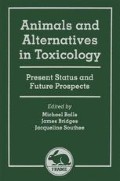Abstract
With the possible exception of the Draize Eye Test, there is nothing in the toxicologist’s armoury that generates more emotion than acute toxicity testing as represented by the LD50. And yet there is no test so misunderstood and misrepresented as to purpose and utility. Stated baldly as ‘finding the dose that kills half the animals’, acute toxicity testing can appear to the layman and the non-toxicological scientist to be so ethically and morally indefensible that it must be replaced forthwith. But to the professional toxicologist, an acute toxicity test can give such valuable information on a new chemical, rapidly and with greater economy of animal usage than many other tests, that it is often regarded as one of the keystones of the profession.
Preview
Unable to display preview. Download preview PDF.
REFERENCES
Trevan, J.E. (1927). The error of determination of toxicity. Proceedings of the Royal Society 101, 483–491.
Anon. (1984). Council Directive 84/449/EEC, adapting to technical progress for the sixth time Council Directive 67/548/EEC on the approximation of the laws, regulations and administrative provisions relating to the classification, packaging and labelling of dangerous substances. Annex V test methods. Part B. Methods for the determination of toxicity. Official Journal of the European Communities L251, 1–223.
Anon. (1984). Committee for Proprietory Medicinal Products (CPMP): Guidelines on acute toxicity studies. The Official Journal of the European Communities C293, 1–47.
Anon. (1979). Council Directive 79/831/EEC, adapting for the sixth time Council Directive 67/548/EEC on the approximation of the laws, regulations and administrative provisions relating to the classification, packaging and labelling of dangerous substances. Official Journal of the European Communities L259, 10–28.
US Environmental Protection Agency (1979). Proposed health effects test standards for Toxic Substances Control Act test rules and proposed good laboratory practice standards for health effects. Federal Register 44, 44054–44059, 44066–44067.
Anon. (1978). Council Directive 78/631/EEC as to the classification, packaging and labelling of dangerous preparations (pesticides). Official Journal of the European Communities L206, 13–23.
US Environmental Protection Agency (1978). Proposed guidelines for registering pesticides in the US. Hazard evaluation: humans and domestic animals. Federal Register 43, 37336–37345, 37351–37356.
Anon. (1976). Council Directive 76/768/EEC on the approximation of the laws of Member States relating to cosmetic products. Official Journal of the European Communities L262, 169–200.
Anon. (1989). U.N. Transport of Dangerous Substances Recommendations. ST/SG/AC-10/ 11. New York: United Nations.
Anon. (1981). Guidelines for the testing of chemicals No. 401: acute oral toxicity. Paris: OECD.
Anon. (1987). Guidelines for the testing of chemicals No. 404: acute oral toxicity. Paris: OECD.
British Toxicological Society (1984). A new approach to the classification of substances and preparations on the basis of their acute toxicity. Human Toxicology 3, 85–92.
Van den Heuvel, M.J., Dayan, A.D. & Shillaker, R.O. (1987). Evaluation of the BTS approach to the testing of substances and preparations for their acute toxicity. Human Toxicology 6, 279–291.
Van den Heuvel, M.J., Clark, D.C., Fielder, R.J., Koundakyian, P.P., Oliver, G.J.A.,Pelling, D., Tomlinson, N.J. and Walker, A.P. (1990). The international validation of a fixed dose procedure as an alternative to the classicial LD50 test. Food and Chemical Toxicology 28, 469–482.
Bondesson, I., Ekwall, B., Hellberg, S., Romert, L., Stenberg, K. & Walum, E. (1989). MEIC—a new international multicenter project to evaluate the relevance to human toxicity of in vitro cytotoxicity tests. Cell Biology and Toxicology 5, 331–347.
Ekwall, B., Bondesson, I., Hellberg, S., Högberg, J., Romert, L., Stenberg, K. & Walum, E. (1991). Validation of in vitro cytotoxicity tests: past and present strategies compared with the MEIC approach. ATLA, 19, 226–233.
Ekwall, B., Bondesson, I., Castell, J., Gómez-Lechón, M. J., Hellberg, S., Högberg, J., Jover, R., Ponsoda, X., Romert, L., Stenberg, K. & Walum, E. (1989). Cytotoxicity evaluation of the first ten MEIC chemicals: acute lethal toxicity in man predicted by cytotoxicity in five cellular assays and by oral LD50 tests in rodents. ATLA 17, 83–100.
Castell, J. V. (1990). Remarks of the winner of the EFPIA award. In Medicines Research and Animal Experimentation: Further Steps to a Solution, pp. 17–19. Aulendorf, Germany: Editio Cantor Verlag.
Author information
Authors and Affiliations
Editor information
Editors and Affiliations
Copyright information
© 1991 FRAME
About this chapter
Cite this chapter
Clark, D.G., Fielder, R., Joseph, C., Gardner, J., Smith, M. (1991). The Future for Acute Oral Toxicity Testing. In: Balls, M., Bridges, J., Southee, J. (eds) Animals and Alternatives in Toxicology. Palgrave, London. https://doi.org/10.1007/978-1-349-12667-5_1
Download citation
DOI: https://doi.org/10.1007/978-1-349-12667-5_1
Publisher Name: Palgrave, London
Print ISBN: 978-1-349-12669-9
Online ISBN: 978-1-349-12667-5
eBook Packages: EngineeringEngineering (R0)

